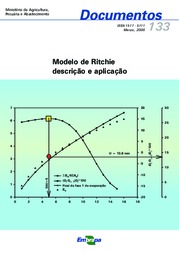Modelo de Ritchie: descrição e aplicação.
Modelo de Ritchie: descrição e aplicação.
Author(s): RODRIGUES, L. N.; AZEVEDO, J. A. de; SOCCOL, O. J.; SILVA, E. M. da
Summary: ABSTRACT: Among the several methods used to manage irrigation, the ones based on the calculation of crop water consumption or evapotranspiration are the most common. From those, the one presented by Doorenbos e Pruitt (1977) is the most used. Based on this method, the crop evapotranspiration is calculated multiplying a crop reference evapotranspiration by a crop coefficient. Applying this methodology in some situations is not convenient, for instance, in the estimative of crop water use efficiency. Besides of this, a good estimative of crop coefficient is difficult and should be done for each region, once is site specific. Options to this method are the models that calculate the evaporation and transpiration separately. Among those, the one presented by Ritchie (1972) is the most popular. It was developed to calculate row crop evapotranspiration in situations where neither soil water deficit occur nor crop is in senescence stage. This model has been used successfully to estimate crop evapotranspiration under different climatic, soil and crop conditions. To use this model it is necessary to estimate two soil parameters. Even though the methodology to estimate these two parameters is of easy application. It is not widely known. The objectives of this paper were: i) to describe the Ritchie model and apply it to calculate the evapotranspiration of Cerrados' crop; and ii) to present methodologies to estimate both its soil parameter and the crop leaf are index.
Publication year: 2005
Types of publication: Booklets
Unit: Embrapa Cerrados
Observation
Some of Embrapa's publications are published as ePub files. To read them, use or download one of the following free software options to your computer or mobile device. Android: Google Play Books; IOS: iBooks; Windows and Linux: Calibre.
Access other publications
Access the Agricultural Research Database (BDPA) to consult Embrapa's full library collection and records.
Visit Embrapa Bookstore to purchase books and other publications sold by Embrapa.

